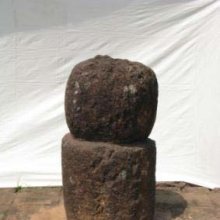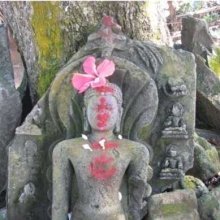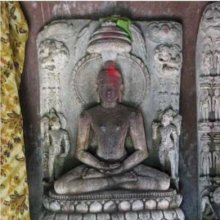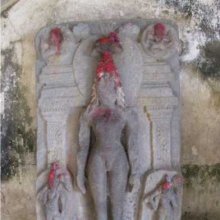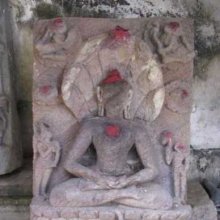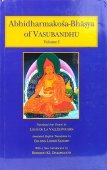Li, Ḷ, Ḹ, Ḻ, Ḻi, Ḻī, Ḷi: 14 definitions
Introduction:
Li means something in Hinduism, Sanskrit, Marathi, Jainism, Prakrit, Hindi, biology, Tamil. If you want to know the exact meaning, history, etymology or English translation of this term then check out the descriptions on this page. Add your comment or reference to a book if you want to contribute to this summary article.
The Sanskrit terms Ḷ and Ḹ and Ḷi can be transliterated into English as L or Li or Lii, using the IAST transliteration scheme (?).
Images (photo gallery)
(+38 more images available)
In Hinduism
Purana and Itihasa (epic history)
Source: Cologne Digital Sanskrit Dictionaries: The Purana IndexḶ (ऌ).—The tenth face of fourteen-faced deva; Sāvarṇika Manu came from it.*
- * Vāyu-purāṇa 26. 42
{@Va@}

The Purana (पुराण, purāṇas) refers to Sanskrit literature preserving ancient India’s vast cultural history, including historical legends, religious ceremonies, various arts and sciences. The eighteen mahapuranas total over 400,000 shlokas (metrical couplets) and date to at least several centuries BCE.
Vyakarana (Sanskrit grammar)
Source: Wikisource: A dictionary of Sanskrit grammar1) L (ल्).—A consonant of the dental class which is a semi-vowel (यण् (yaṇ)) with liquid contact in the mouth, and which is inaspirate (अल्पप्राण (alpaprāṇa)),voiced (घोष (ghoṣa)) and both nasalised and unnasalised;
2) L.—Name in general (लकार (lakāra)) given to the personal endings applied to roots in the ten tenses and moods which take different substitutes ति, तः, अन्ति (ti, taḥ, anti) etc. and have various modifications and augments in the different tenses and moods;
3) L.—Substituted as a semi-vowel (यण् (yaṇ)) for the vowel ऌ (ḷ) followed by any other vowel in the euphonic combinations;
4) L.—Applied at the beginning of nontaddhita affixes as a mute letter indicating the acute accent for the vowel preceding the affix; cf. लिति (liti); P. VI. 1.193;
5) L.—Substituted for त्, थ्, द्, घ् (t, th, d, gh) or न् (n) before ल् (l), cf. P.VIII.4. 60;
6) L.—Substituted under certain conditions for the consonant र् (r) (a) of the root कृप् (kṛp), (b) of prefixes प्र (pra) and परा (parā) before the root अय् (ay), (c) of the root गॄ (gṝ) in frequentative forms and optionally before affixes beginning with a vowel, and (d) of the word परि (pari) before घ (gha) and अङ्क (aṅka); cf. P. VIII. 2. 18 to 22.
--- OR ---
Li (लि).—A common term used (1) for the aorist vikaraṇa affix च्लि (cli) for which सिच्, क्स, अङ् (sic, ksa, aṅ) etc. are substituted as prescribed; (2) for लिट् (liṭ) and लिङ् (liṅ) affixes; e.g. मन्त्रे घसह्वरणशवृदहाद्-वृच्कृगमिजनिभ्यो लेः (mantre ghasahvaraṇaśavṛdahād-vṛckṛgamijanibhyo leḥ) P.II.4.80.

Vyakarana (व्याकरण, vyākaraṇa) refers to Sanskrit grammar and represents one of the six additional sciences (vedanga) to be studied along with the Vedas. Vyakarana concerns itself with the rules of Sanskrit grammar and linguistic analysis in order to establish the correct context of words and sentences.
Biology (plants and animals)
Source: Google Books: CRC World Dictionary (Regional names)1) Li in China is the name of a plant defined with Allium victorialis in various botanical sources. This page contains potential references in Ayurveda, modern medicine, and other folk traditions or local practices It has the synonym Geboscon lanceolatum Raf. (among others).
2) Li is also identified with Castanea sativa It has the synonym Fagus procera Salisb., nom. illeg. (etc.).
3) Li is also identified with Chenopodium album It has the synonym Atriplex alba Salisb. (etc.).
4) Li is also identified with Chenopodium hederiforme It has the synonym Atriplex alba Scop. (etc.).
5) Li is also identified with Prunus salicina It has the synonym Prunus triflora Roxb. (etc.).
Example references for further research on medicinal uses or toxicity (see latin names for full list):
· Nouvelles archives du muséum d’histoire naturelle (1885)
· Systema Vegetabilium, ed. 15 (1820)
· Opera Botanica a Societate Botanica Lundensi (1999)
· Species Plantarum (1753)
· Prodromus Florae Nepalensis (1825)
· Annales Botanici Fennici (1977)
If you are looking for specific details regarding Li, for example chemical composition, pregnancy safety, diet and recipes, extract dosage, health benefits, side effects, have a look at these references.

This sections includes definitions from the five kingdoms of living things: Animals, Plants, Fungi, Protists and Monera. It will include both the official binomial nomenclature (scientific names usually in Latin) as well as regional spellings and variants.
Languages of India and abroad
Marathi-English dictionary
Source: DDSA: The Aryabhusan school dictionary, Marathi-Englishlī (ली).—or-
--- OR ---
ḷī (ळी).—or-
--- OR ---
lī (ली).—or-
Marathi is an Indo-European language having over 70 million native speakers people in (predominantly) Maharashtra India. Marathi, like many other Indo-Aryan languages, evolved from early forms of Prakrit, which itself is a subset of Sanskrit, one of the most ancient languages of the world.
Sanskrit dictionary
Source: DDSA: The practical Sanskrit-English dictionaryḸ (ॡ).—f. A mother, a divine female. -m. Śiva. -f. = [lṛ.] cf. ॡर्महात्मा सुरो बालो भूपः स्तोमः कथानकः (ḹrmahātmā suro bālo bhūpaḥ stomaḥ kathānakaḥ) (vaktā) । मूर्खो शिश्नो गुदः कक्षा केशः पापरतो नरः (| mūrkho śiśno gudaḥ kakṣā keśaḥ pāparato naraḥ) || Enm.
--- OR ---
Li (लि).—
1) Fatigue.
2) Destruction, loss.
3) End.
4) Equality.
5) A bracelet.
Derivable forms: liḥ (लिः).
--- OR ---
Lī (ली).—I. 1 P. (layati) To melt, dissolve. -II. 9 P. (lināti)
1) To adhere.
2) To melt, usually with वि (vi). -III. 4 Ā. (līyate, līna)
1) To stick or adhere firmly to, cling to.
2) To clasp, embrace.
3) To lie or rest on, recline, stay or dwell in, lurk, hide, cower down; (bhṛṅgāṅganāḥ) लीयन्ते मुकुलान्तरेषु शनकैः संजातलज्जा इव (līyante mukulāntareṣu śanakaiḥ saṃjātalajjā iva) Ratnāvalī 1. 26; हरिशिशुरुत्पतितुं द्रागङ्गान्याकुञ्च्य लीयते निमृतम् (hariśiśurutpatituṃ drāgaṅgānyākuñcya līyate nimṛtam) Bv.1.16; R.3.9; Ś.6.16; Kumārasambhava 1.12;7.21; Bhaṭṭikāvya 18.13; Kirātārjunīya 5. 26.
4) To be dissolved, melt away.
5) To be sticky or viscous.
6) To be absorbed in, be devoted or attached to; माधव मनसिजविशिखभयादिव भावनया त्वयि लीना (mādhava manasijaviśikhabhayādiva bhāvanayā tvayi līnā) Gītagovinda 4
7) To vanish, disappear. -Caus. (lāpayati-te, lāyayati-te, līnayati-te, lālayati-te) To melt, dissolve, liquefy. (The form lāpayate is used in the sense of 'to honour', 'cause to be honoured'; jaṭābhirlāpayate = pūjāmadhigacchati; cf. P.I.3.7.).
--- OR ---
Lī (ली).—f.
1) Adhering, clinging to.
2) Embracing
3) Melting, dissolving.
Derivable forms: līḥ (लीः).
Source: Cologne Digital Sanskrit Dictionaries: Shabda-Sagara Sanskrit-English DictionaryḶ (ऌ).—The ninth vowel of the Nagari Alphabet, having the power of Lri, but more usually considered to be expressed by Li as in Lily.
--- OR ---
Ḷ (ऌ).—aptote. 1. The divine nature. 2. The earth. 3. A mountain. ind. A mystical letter. ḹ
--- OR ---
Ḹ (ॡ).—The long vowel corresponding to the preceding short one, Lri or Li.
--- OR ---
Ḹ (ॡ).—aptote. 1. A divine female. 2. The female nature. 3. A mother. m. (ḹḥ) A name of Siva. f. (ḹḥ) 1. The mother of the demons. 2. The mother of the all-bestowing cow. ind. A mystical letter used once or repeatedly in many Mantras or mystical formulæ. The letters ṝ and ḷ are employed in the same manner: they have apparently no signification, but are personified and invested with marvellous properties in the Tantras. e
--- OR ---
Li (लि).—m.
(-liḥ) 1. Weariness. 2. Loss, destruction. 3. End, term. 4. Equality, sameness. 5. A bracelet. E. lā to take, or lī to melt, &c., aff. ki .
--- OR ---
Lī (ली).—r. 1st cl. (layati) To melt, to liquefy. r. 4th cl. (līyate) 1. To stick together. 2. To lurk in, to hide in. 3. To be dissolved. 4. To be sticky. 5. To be devoted to. 6. To vanish, to disappear. With abhi, To cover, to spread over. With ā, 1. To cover, to besmear. 2. To lurk or hide in. With ni, 1. To lie down, to alight. 2. To conceal oneself, (with an abl.) 3. To perish. With pra, 1. To be absorbed in. 2. To vanish. With vi, 1. To cleave to. 2. To settle on. 3. To melt away. 4. To disappear, to perish. With sama, 1. To cling to. 2. To lie down. 3. To be concealed. 4. To melt away. r. 9th cl. (lināti) 1. To join, to adhere or cling to, to be in union or connection with. 2. To obtain. 3. To melt. 4. To be absorbed. With vi, To melt away. r. 10th cl. (layati lāyayati-te lāpayati-te lālayati-te līnayati-te) To melt, to liquefy, to fuse or dissolve. With āṅ, To waste away. With pra and vi, To acquire or gain. According to Panini the form lāpayate is used in the sense of “To obtain honour.”
--- OR ---
Lī (ली).—f.
(-līḥ) Embracing. E. lī to embrace, kvip aff.
Source: Cologne Digital Sanskrit Dictionaries: Benfey Sanskrit-English DictionaryLī (ली).— (the original signification is ‘To be viscous,’ then ‘To be solvable’), i. 1 and 10, [Parasmaipada.] To melt, to liquefy, to dissolve. ii. 9. linā, linī, [Parasmaipada.] 1. To adhere. 2. To obtain. i. 4, [Ātmanepada.] (properly pass.), 1. To be dissolved, to vanish, Böhtl. Ind. Spr. 450. 2. To adhere or cling to. 3. To dwell, to live, to haunt, Mahābhārata 1, 4310. Ptcple. of the pf. pass. līna. 1. Melted, dissolved, [Vedāntasāra, (in my Chrestomathy.)] in
— With the prep. antar antar, antarlīna, Inherent, staying; haunting in the interior, [Pañcatantra] 109, 19; i. [distich] 420; [Uttara Rāmacarita, 2. ed. Calc., 1862.] 56, 10; (not coming out), [Pañcatantra] 175, 24. Acc. sing. ºnam, adv. Inwardly, [Pañcatantra] 185, 3.
— With apa apa, [Causal.] lāpaya, [Ātmanepada.] To deceive, [Bhaṭṭikāvya, (ed. Calc.)] 8, 44.
— With abhi abhi, abhilīna, Adhering, [Meghadūta, (ed. Gildemeister.)] 37.
— With ava ava, To cling to, [Nala] 2, 46.
— With samava sam-ava, i. 4, To be dissolved, [Vedāntasāra, (in my Chrestomathy.)] in
— With ā ā, i. 4, To faint, Mahābhārata 3, 2573.
— With ni ni, i. 4, 1. To alight, to settle, Mahābhārata 3, 10560. 2. To lie down, Mahābhārata 3, 12091. 3. To hide one’s self, Mahābhārata 3, 10978. nilīna, 1. Fused in or into. 2. Transformed. 3. Destroyed. 4. Encompassed. 5. Full.
— With saṃni sam -ni, i. 4, To lie down, Mahābhārata 3, 13654.
— With pra pra, i. 4, 1. To be dissolved or absorbed, [Mānavadharmaśāstra] 1, 54. 2. To die, [Mānavadharmaśāstra] 4, 240. 3. To unite intimately, [Mānavadharmaśāstra] 12, 17. pralīna, 1. Destroyed. 2. Unconscious, insensible.
— With saṃpra sam-pra, pass. To be destroyed, [Hitopadeśa] iii. [distich] 129.
— With vi vi, i. 4, 1. To alight, [Śiśupālavadha] 1, 12. 2. To be dissolved, to vanish, [Pañcatantra] ii. [distich] 98; to become ineffectual, iii. [distich] 74. vilina, 1. Liquefied, melted. 2. Dissolved, Böhtl. Ind. Spr. 830; [Lassen, Anthologia Sanskritica.] 11, 15. 3. Disappeared. 4. Imagined. 5. United. Comp. A-, adj. living, [Uttara Rāmacarita, 2. ed. Calc., 1862.] 168, 7. [Causal.] vi-lāyaya, -lāpaya, -līnaya (properly a [denominative.] derived from vilīna), lālaya (also a [denominative.] from lālā with vi), To dissolve. vilāyita, Dissolved, [Prabodhacandrodaya, (ed. Brockhaus.)] 116, 8.
— With pravi pra-vi, i. 4, To be dissolved, to vanish, [Bhagavadgītā, (ed. Schlegel.)] 4, 23.
— With sam sam, saṃlīna, 1. Joined, put together, [Pañcatantra] 163, 6. 2. Staying, Mahābhārata 1, 7671.
— Cf. [Latin] līmus (borrowed [Old High German.] lim; [Anglo-Saxon.] líme, and [Old High German.] leim; [Anglo-Saxon.] lám), po-līre, linere;
Source: Cologne Digital Sanskrit Dictionaries: Cappeller Sanskrit-English DictionaryLī (ली).—1. līyate līyati (layate only [with] ni), [participle] līna (q.v.) cling, adhere, stick, light or sit upon (of birds & insects); stoop, cower; slip into, disappear. [Causative] lāpayati & lāyayati v. sub vi.
--- OR ---
Lī (ली).—2. only [Intensive] lelāyate be unsteady, waver, tremble.
Source: Cologne Digital Sanskrit Dictionaries: Monier-Williams Sanskrit-English Dictionary1) Ḷ (ऌ):—1. ḷ the ninth vowel of the alphabet (resembling the sound lry in revelry; it only appears in some forms of √kḷp).
2) 2. ḷ m. a mountain, [cf. Lexicographers, esp. such as amarasiṃha, halāyudha, hemacandra, etc.]
3) the earth, the mother of the gods, [cf. Lexicographers, esp. such as amarasiṃha, halāyudha, hemacandra, etc.]
4) Ḹ (ॡ):—1. ḹ the tenth vowel of the alphabet (the corresponding long vowel to ḷ, entirely artificial and only appearing in the works of some grammarians and lexicographers).
5) 2. ḹ m. Śiva, [cf. Lexicographers, esp. such as amarasiṃha, halāyudha, hemacandra, etc.]
6) f. the mother of the cow of plenty
7) the mother of the Dānavas
8) wife of a Daitya
9) mother
10) divine female
11) female nature.
12) Li (लि):—m. (only [cf. Lexicographers, esp. such as amarasiṃha, halāyudha, hemacandra, etc.]; perhaps connected with √lī) weariness, fatigue
13) loss, destruction
14) end, term
15) equality, sameness
16) a bracelet
17) (in gram.) abbreviated form of, liṅga (See li-dhu).
18) Lī (ली):—1. lī (cf. √rī) [class] 9. [Parasmaipada] ([Dhātupāṭha xxxi, 31]) lināti, to adhere, obtain (not usually found);
— [class] 1. [Parasmaipada] layati ([xxxiv, 6]), to melt, liquefy, dissolve (not usually found);—[class] 4. [Ātmanepada] ([xxvi, 30]) līyate ([Vedic or Veda] also lāyate; [perfect tense] lilye, lilyuḥ, [Brāhmaṇa] etc.; lilāya, lalau [grammar]; [Aorist] aleṣṭa, [Śatapatha-brāhmaṇa]; alaiṣīt, alāsīt, alāsta [grammar]; [future] letā, lātā; leṣyati or lāsyati, te, [ib.]; [infinitive mood] letum or lātum [ib.]; [indeclinable participle] -lāyam, [Atharva-veda; Brāhmaṇa]; līya, [Mahābhārata; Kāvya literature] etc.),
—to cling or press closely, stick or adhere to ([locative case]), [Mahābhārata; Rāmāyaṇa] etc.;
—to remain sticking, [Suśruta];
—to lie, recline, alight or settle on, hide or cower down in ([locative case]), disappear, vanish, [Mahābhārata; Kāvya literature] etc.:—[Causal] [Parasmaipada] lāpayati or lāyayati, to cause to cling etc., [Brāhmaṇa] etc.;
— [Ātmanepada] lāpayate, to deceive;
—to obtain honour;
—to humble, [Pāṇini 1-3, 70] :—[Desiderative] lilīṣati, te [grammar]:—[Intensive] lelīyate, lelayīti, leleti, [ib.] (cf. lelāya).
19) 2. lī f. clinging to, adhering etc., [cf. Lexicographers, esp. such as amarasiṃha, halāyudha, hemacandra, etc.]
20) = capala, [cf. Lexicographers, esp. such as amarasiṃha, halāyudha, hemacandra, etc.]
Source: Cologne Digital Sanskrit Dictionaries: Yates Sanskrit-English Dictionary1) Ḷ (ऌ):—The ninth vowel of the Nāgari alphabet, lri.
2) An aptote. The divine nature; earth; mountain; a mystic letter.
3) Ḹ (ॡ):—The long vowel corresponding with the preceding short one.
4) An aptote. The divine nature; mother. (ḹḥ) m. Shiva, (ḹḥ) f. The mother of the demons; Kāmdhenu; a mystic letter.
5) Li (लि):—(liḥ) 2. m. Weariness; loss, end; equality; a bracelet.
6) Lī (ली):—(ya, ṅa) līyate 4. d. (gi) lināti 9. a. To join, to be in contact, to obtain. (ki) layati lāyayati 10. a. To melt. With ā to waste away; with ut to jump; with pra and vi to acquire.
7) (līḥ) 3. f. Embracing.
[Sanskrit to German]
Sanskrit, also spelled संस्कृतम् (saṃskṛtam), is an ancient language of India commonly seen as the grandmother of the Indo-European language family (even English!). Closely allied with Prakrit and Pali, Sanskrit is more exhaustive in both grammar and terms and has the most extensive collection of literature in the world, greatly surpassing its sister-languages Greek and Latin.
Hindi dictionary
Source: DDSA: A practical Hindi-English dictionary1) L in Hindi refers in English to:——traditionally, the third of the semi-vowel series [ya, ra, la, va] of the Devnagri: alphabet. Modern phoneticians do not, however, recognise the letter as a semi-vowel in Hindi but as a consonant..—l (ल) is alternatively transliterated as La.
2) Lī (ली):—(v) past participle feminine singular form of the verb [lenā].
...
Prakrit-English dictionary
Source: DDSA: Paia-sadda-mahannavo; a comprehensive Prakrit Hindi dictionaryLī (ली) in the Prakrit language is related to the Sanskrit word: Kadali.
Lī has the following synonyms: Kayali.
Prakrit is an ancient language closely associated with both Pali and Sanskrit. Jain literature is often composed in this language or sub-dialects, such as the Agamas and their commentaries which are written in Ardhamagadhi and Maharashtri Prakrit. The earliest extant texts can be dated to as early as the 4th century BCE although core portions might be older.
See also (Relevant definitions)
Starts with (+1750): Leelavatar, Li ban ji sheng, Li chih, Li du canada, Li ga du, Li ga dur, Li guo ji sheng, Li jiang chai hu, Li jiang gao ben, Li jiang huang qin, Li jiang ma huang, Li ka dur, Li la gen, Li lan wang, Li liao, Li lu, Li titi, Li ye xuan gou zi, Li zhi, Li zhi cao.
Ends with (+9980): A-kam-a-loli, Aadama balli, Aadu balli, Aadu kolli, Aaduballi, Aaichuli, Aakaasha balli, Aakaasha-balli, Aakaashagaruda balli, Aakasha balli, Aakashaballi, Aakashavalli, Aalali, Aali, Aamaradaavalli, Aangaaravalli, Aarampuli, Aaronpuli, Aashaadi balli, Aashaali.
Full-text (+91468): Keli, Pali, Rajavali, Lim, Vihitanjali, Matali, Mauli, Cacali, Sarali, Shephali, Prahvanjali, Dehali, Ili, Balashalin, Kutuhalin, Shalmali, Ali, Kushalin, Pauli, Dhuli.
Relevant text
One of your search terms exceeds the minimun character amount per search term. This amount currently equals 2.
No search results for Li, Ḷ, L, Ḹ, Ḻ, Lee, Lī, Ḷī, Ḻi, Ḻī, Ḷi; (plurals include: Lees) in any book or story.
Related products
(+12 more products available)

